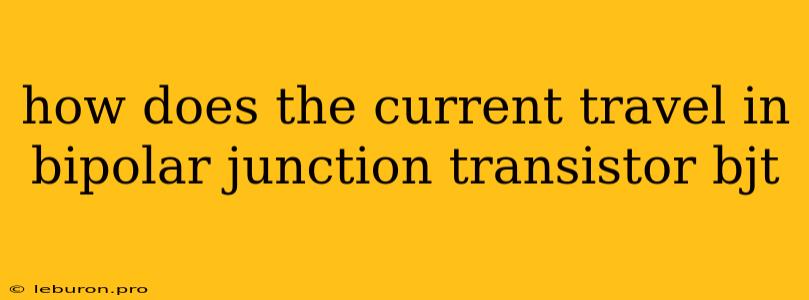Understanding how current flows in a Bipolar Junction Transistor (BJT) is essential for comprehending its functionality and applications in electronic circuits. The BJT, a three-terminal semiconductor device, operates by controlling the flow of current through a small base current, which in turn influences a larger collector current. This article will delve into the intricacies of current flow in a BJT, examining the different regions of operation and the factors affecting its behavior.
BJT Structure and Current Flow
A BJT consists of three distinct semiconductor regions: the emitter, the base, and the collector. These regions are arranged in a sandwich-like structure, with two junctions formed between them. The emitter is heavily doped, while the base is lightly doped, and the collector is moderately doped. This doping pattern dictates the direction of current flow within the transistor.
Forward-Biased Emitter-Base Junction
The key to current flow in a BJT lies in the forward-biased emitter-base junction. When a positive voltage is applied to the base relative to the emitter, the junction becomes forward-biased. This creates an electric field that pushes electrons from the emitter into the base region.
Base Current and Electron Diffusion
The injected electrons from the emitter constitute the base current, which is relatively small. However, the base region is very thin, and most of the electrons injected from the emitter do not recombine with holes in the base. Instead, they diffuse through the base region towards the collector.
Collector-Base Junction and Collector Current
The collector-base junction is reverse-biased. This means that there is a strong electric field within the collector region, which attracts the electrons that have diffused across the base. The flow of electrons from the base to the collector constitutes the collector current, which is significantly larger than the base current.
Modes of Operation
BJTs can operate in three distinct modes:
-
Active Mode: This is the primary mode of operation for BJTs, where the transistor acts as an amplifier. In active mode, the emitter-base junction is forward-biased, and the collector-base junction is reverse-biased. The transistor amplifies the base current by controlling the flow of a larger collector current.
-
Cut-off Mode: In this mode, both the emitter-base and collector-base junctions are reverse-biased. This results in a negligible current flow through the transistor.
-
Saturation Mode: This mode occurs when the emitter-base junction is forward-biased, and the collector-base junction becomes forward-biased. This results in a large collector current, but the transistor loses its ability to amplify the base current.
Factors Affecting Current Flow
Several factors influence the current flow in a BJT, including:
-
Base Current: The base current directly controls the collector current. A higher base current leads to a larger collector current.
-
Base Width: The thickness of the base region impacts the diffusion of electrons from the emitter to the collector. A narrower base width results in a higher collector current.
-
Collector-Base Voltage: Increasing the collector-base voltage enhances the electric field within the collector region, leading to a greater attraction of electrons from the base and thus a larger collector current.
-
Temperature: The temperature of the transistor influences the rate of diffusion of electrons in the base region. Higher temperatures can result in a larger collector current.
Current Gain (β)
The current gain of a BJT is a crucial parameter that describes the relationship between the base current and the collector current. It is defined as the ratio of the collector current to the base current:
β = Ic / Ib
The current gain typically ranges from 50 to 300 for common BJTs. This means that a small change in the base current can result in a significant change in the collector current, highlighting the amplifying capability of the transistor.
Conclusion
Understanding the current flow in a BJT is essential for circuit design and analysis. The transistor operates by controlling the flow of collector current through a small base current, which is made possible by the forward-biased emitter-base junction and the reverse-biased collector-base junction. The base width, collector-base voltage, and temperature are key factors that influence the current flow and the transistor's performance. By understanding these principles, engineers can effectively utilize BJTs in various electronic applications, including amplifiers, switches, and oscillators.
